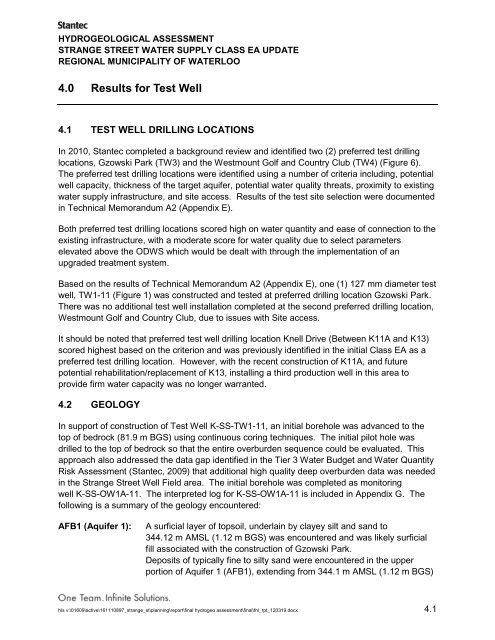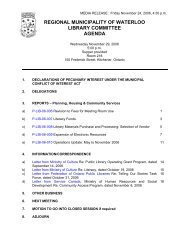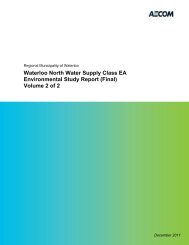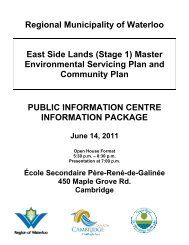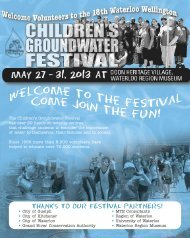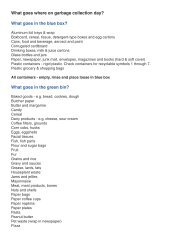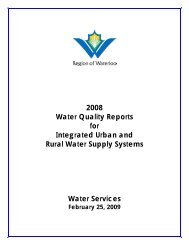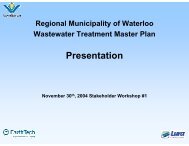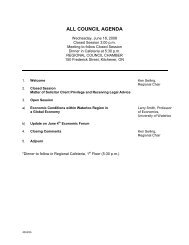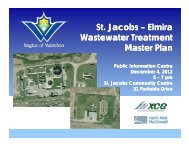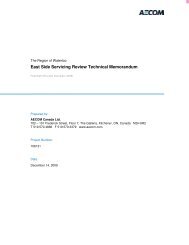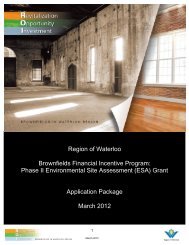Sam Ziemann From - Region of Waterloo
Sam Ziemann From - Region of Waterloo
Sam Ziemann From - Region of Waterloo
Create successful ePaper yourself
Turn your PDF publications into a flip-book with our unique Google optimized e-Paper software.
HYDROGEOLOGICAL ASSESSMENTSTRANGE STREET WATER SUPPLY CLASS EA UPDATEREGIONAL MUNICIPALITY OF WATERLOO4.0 Results for Test Well4.1 TEST WELL DRILLING LOCATIONSIn 2010, Stantec completed a background review and identified two (2) preferred test drillinglocations, Gzowski Park (TW3) and the Westmount Golf and Country Club (TW4) (Figure 6).The preferred test drilling locations were identified using a number <strong>of</strong> criteria including, potentialwell capacity, thickness <strong>of</strong> the target aquifer, potential water quality threats, proximity to existingwater supply infrastructure, and site access. Results <strong>of</strong> the test site selection were documentedin Technical Memorandum A2 (Appendix E).Both preferred test drilling locations scored high on water quantity and ease <strong>of</strong> connection to theexisting infrastructure, with a moderate score for water quality due to select parameterselevated above the ODWS which would be dealt with through the implementation <strong>of</strong> anupgraded treatment system.Based on the results <strong>of</strong> Technical Memorandum A2 (Appendix E), one (1) 127 mm diameter testwell, TW1-11 (Figure 1) was constructed and tested at preferred drilling location Gzowski Park.There was no additional test well installation completed at the second preferred drilling location,Westmount Golf and Country Club, due to issues with Site access.It should be noted that preferred test well drilling location Knell Drive (Between K11A and K13)scored highest based on the criterion and was previously identified in the initial Class EA as apreferred test drilling location. However, with the recent construction <strong>of</strong> K11A, and futurepotential rehabilitation/replacement <strong>of</strong> K13, installing a third production well in this area toprovide firm water capacity was no longer warranted.4.2 GEOLOGYIn support <strong>of</strong> construction <strong>of</strong> Test Well K-SS-TW1-11, an initial borehole was advanced to thetop <strong>of</strong> bedrock (81.9 m BGS) using continuous coring techniques. The initial pilot hole wasdrilled to the top <strong>of</strong> bedrock so that the entire overburden sequence could be evaluated. Thisapproach also addressed the data gap identified in the Tier 3 Water Budget and Water QuantityRisk Assessment (Stantec, 2009) that additional high quality deep overburden data was neededin the Strange Street Well Field area. The initial borehole was completed as monitoringwell K-SS-OW1A-11. The interpreted log for K-SS-OW1A-11 is included in Appendix G. Thefollowing is a summary <strong>of</strong> the geology encountered:AFB1 (Aquifer 1):A surficial layer <strong>of</strong> topsoil, underlain by clayey silt and sand to344.12 m AMSL (1.12 m BGS) was encountered and was likely surficialfill associated with the construction <strong>of</strong> Gzowski Park.Deposits <strong>of</strong> typically fine to silty sand were encountered in the upperportion <strong>of</strong> Aquifer 1 (AFB1), extending from 344.1 m AMSL (1.12 m BGS)hls v:\01609\active\161110897_strange_st\planning\report\final hydrogeo assessment\final\fnl_rpt_120319.docx 4.1


